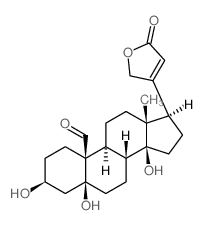Card-20(22)-enolide,3,5,14-trihydroxy-19-oxo-, (3b,5b)-

Card-20(22)-enolide,3,5,14-trihydroxy-19-oxo-, (3b,5b)- structure
|
Common Name | Card-20(22)-enolide,3,5,14-trihydroxy-19-oxo-, (3b,5b)- | ||
|---|---|---|---|---|
| CAS Number | 66-28-4 | Molecular Weight | 404.49700 | |
| Density | 1.432 g/cm3 | Boiling Point | 620.7ºC at 760 mmHg | |
| Molecular Formula | C23H32O6 | Melting Point | 169ºC | |
| MSDS | Chinese USA | Flash Point | 214.9ºC | |
| Symbol |

GHS06 |
Signal Word | Danger | |
|
Determination of strophanthidin in ingesta and plant material by LC-MS/MS.
J. Agric. Food Chem. 52 , 2174-8, (2004) An LC-MS/MS method was developed for the semiquantitative determination of strophanthidin glycosides in ingesta from animals. Strophanthidin glycosides were simultaneously extracted and hydrolyzed to the strophanthidin aglycone using aqueous methanolic hydroc... |
|
|
Mechanistic insight into the functional and toxic effects of Strophanthidin in the failing human myocardium.
Eur. J. Heart Fail. 9(11) , 1086-94, (2007) Cardiac glycosides are characterized by a narrow therapeutic range with Ca2+-overload and arrhythmias occurring at higher concentrations. Data on cardiac glycosides in isolated failing human myocardium are scarce and the frequency-dependent actions and toxici... |
|
|
Summer pheasant's eye (Adonis aestivalis) poisoning in three horses.
Vet. Pathol. 41(3) , 215-20, (2004) Three horses died as a result of eating grass hay containing summer pheasant's eye (Adonis aestivalis L.), a plant containing cardenolides similar to oleander and foxglove. A 9-year-old thoroughbred gelding, a 20-year-old appaloosa gelding, and a 5-year-old q... |
|
|
Diurnal modulation of the Na+/K+-ATPase and spontaneous firing in the rat retinorecipient clock neurons.
J. Neurophysiol. 92(4) , 2295-301, (2004) The ventral "core" suprachiasmatic nucleus (vSCN) neurons are the retinorecipient neurons in the mammalian circadian clock and maintain a diurnal firing rhythm in reduced preparations. We tested the possibility that daily changes in Na+/K+-ATPase accompany di... |
|
|
Measurement of the dissociation constant of Fluo-3 for Ca2+ in isolated rabbit cardiomyocytes using Ca2+ wave characteristics.
Cell Calcium 34(1) , 1-9, (2003) The Ca(2+) dissociation constant (K(d)) of Fluo-3 was determined using confocal fluorescence microscopy in two different situations: (i) within the cytosol of a permeabilised cardiomyocyte; and (ii) in an intact cardiomyocyte after incubation with the acetoxy... |
|
|
Intracellular Na(+) and metabolic modulation of Na/K pump and excitability in the rat suprachiasmatic nucleus neurons.
J. Neurophysiol. 108(7) , 2024-32, (2012) Na/K pump activity and metabolic rate are both higher during the day in the suprachiasmatic nucleus (SCN) that houses the circadian clock. Here we investigated the role of intracellular Na(+) and energy metabolism in regulating Na/K pump activity and neuronal... |
|
|
On the mechanisms of arrhythmias in the myocardium of mXinα-deficient murine left atrial-pulmonary veins
Life Sci. 83(7-8) , 272-83, (2008) We have previously shown that left atrial-pulmonary vein tissue (LA-PV) can generate reentrant arrhythmias (atrial fibrillation, AF) in wild-type (mXinα+/+) but not in mXinα-null (mXinα−/−) mice. With the present experiments, we investigated the arrhythmogeni... |
|
|
Relationship between cardiotonic effects and inhibition on cardiac sarcolemmal Na+,K+-ATPase of strophan-thidin at low concentrations.
Acta Pharmacol. Sin. 24(11) , 1103-7, (2003) To evaluate the effects of strophanthidin (Str) on cardiac contractile function and sarcolemmal Na+, K+-ATPase activities in isolated guinea-pig hearts.Isolated guinea-pig hearts were perfused through aorta in a Langendorff mode. Heart rate (HR), left ventric... |
|
|
Evaluation of the toxicity of Adonis aestivalis in calves.
J. Vet. Diagn. Invest. 19(5) , 581-5, (2007) Toxicosis of Adonis aestivalis is well documented in horses, but little is known of its toxicity in cattle. A. aestivalis (summer pheasant's eye) was collected over multiple years, under different growing conditions, and at various stages of maturity, dried, ... |
|
|
Rotenone potentiates NMDA currents in substantia nigra dopamine neurons.
Neurosci. Lett. 421(2) , 96-100, (2007) Rotenone is a pesticide that produces a rodent model of Parkinson's disease. Although much evidence suggests that oxidative stress mediates the toxicity of rotenone on dopamine neurons, rotenone can also potentiate glutamate excitotoxicity. We used whole-cell... |